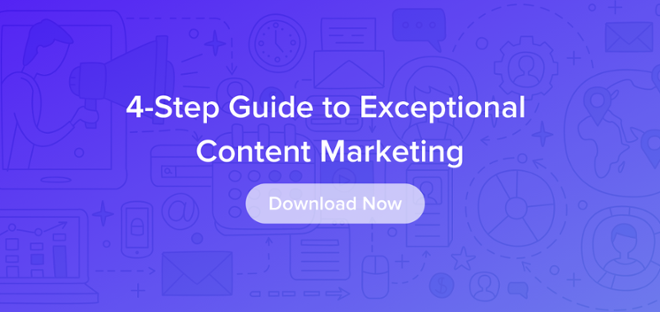 How often do you spend hours making a four-course gourmet meal; set the table with nice linens, candles, and your best china; and sit down to eat your meal alone? Most of us don’t do this — period. It doesn’t make sense for someone to put in hours and hours of careful planning and effort into a project that only one person will enjoy.
How often do you spend hours making a four-course gourmet meal; set the table with nice linens, candles, and your best china; and sit down to eat your meal alone? Most of us don’t do this — period. It doesn’t make sense for someone to put in hours and hours of careful planning and effort into a project that only one person will enjoy.
Now, how often do you spend hours researching, writing, editing, and polishing the perfect piece of content only to maybe upload it to your blog? While you’ve probably cooked yourself four-course gourmet meals fewer times than you’ve created idle content, the principle is the same. Why put all of your time, effort, and company resources into a project that only a few people who happen upon your company blog will ever enjoy?
The sad truth is that 60-70 percent of the content B2B marketers create sits unused, meaning marketers are creating content but not strategically publishing or distributing it. Most likely, this content is being housed in one internal location with very little effort put toward making it available for current and prospective customers to easily access.
In an effort to save you from the content marketing equivalent of cooking a gourmet meal that no one but you can enjoy, here are a few suggestions for ways you can effectively distribute each and every piece of content you create:
1. Distribute in Online Publications
Be honest — how many subscribers does your blog have? If you’re like most small- to mid-sized B2B companies, your blog probably has a few thousand visitors each month, many of whom are already familiar with your brand or are currently in your pipeline. To reach new prospects, your best option is publishing your content in external publications.
Publishing externally doesn’t mean you need to land on the front page of The New York Times, but it does mean you can contribute content to niche publications that reach your target audience. Targeting the publications your audience already reads and engages with is a great way to introduce your content and your company to new prospects. Plus, a smaller group of highly targeted, engaged readers will prove far more valuable than a large group of individuals who have no interest in your content.
If you’re hesitant about this distribution strategy because you just have no idea how to start contributing your articles to external publications, download “The 4-Step Guide to Exceptional Content Marketing” for everything you need to execute successfully.

2. Distribute Internally
Your marketing team creates a lot of content that I bet the rest of your team doesn’t even know exists. While sending emails to the sales team or different account managers about your newest case study on a big client is a helpful start to putting content into the right hands, it lacks any organizational structure and can be hard for team members to find again.
To make your content accessible internally, create a system so your team knows where to look to stay up-to-date on your content, and provide a platform for them to discuss strategies to leverage it. We did this by creating a Slack channel for our blog, “#the-knowledge-bank,” that integrates with Zapier to notify the team when a new blog post is published. Not only does this keep our blog and marketing resources top of mind, but it also serves as a catalyst for team members to discuss content and effective ways to distribute it to their clients and networks.
Full disclosure: Zapier is a company that Influence & Co. has worked with in the past.
Think you're still missing something in your content promotion efforts? Check out our list in, "7 Content Distribution Techniques You Totally Forgot About".
3. Distribute on Social Media
Depending on your specific audience, social distribution can take many forms. While we’ve found success in coordinating our social posts and updates with our editorial calendar to save time, we also use the following checklist to ensure greater social success for each piece of content we distribute:
- Test headlines and captions. Our director of social media uses a blend of quotes, statistics, traditional headlines, images, and questions to entice our followers to click, and users on each platform respond differently to these different methods. Avoid stale, repetitious captions and updates, and test fresh ideas for your various followers.
- Utilize LinkedIn Groups. Relevant LinkedIn Groups are great places to distribute your published content because group members are typically knowledgeable and ready to engage with quality content that adds to the conversation. Keep in mind, though, that people will quickly bump you and your posts if you spam their feeds with promotional content.
- Repurpose content as presentations. Create a SlideShare account to upload various presentation decks, or try converting long-form content into a slideshow for easier consumption. You can also use SlideShare to recap your webinars for readers who missed your event.
- Use paid efforts when it makes sense. Our highest-converting channels are LinkedIn and Twitter, so it makes sense for our team to use LinkedIn Sponsored Updates and Promoted Tweets to increase our reach and engagement. Testing platforms and strategies before devoting a large budget to paid efforts, and consistently evaluating your campaigns, will be helpful in the long run.
4. Distribute to Clients
Too often, companies view content only as a way to attract new customers when, in reality, it’s an essential tool for building loyalty and engagement with current clients. Review the content resources you have that speak directly to current customers. Do you have articles about the best ways to utilize your services? This can be a tool to start the conversation around an upsell or a referral to another potential client.
Your best, most relevant content can make for a highly effective email campaign specifically for your current clients. We started this recently and have already seen positive results. Our clients have responded to our emails to thank us for the additional information and to ask questions we wouldn’t have otherwise known they had — which allows us to continue creating great content for them.
So much of what marketers read stresses the importance of high-quality content creation, and while it’s true that high-quality content is the foundation of a strong campaign, it means nothing if you let it sit unused. Look to external publications, social media, your team, and your clients to get the most from your content.
Are you creating quality content but failing to get the green light from publishers? Download the 2018 State of Digital Media to see what editors want in the content they publish:




 How often do you spend hours making a four-course gourmet meal; set the table with nice linens, candles, and your best china; and sit down to eat your meal alone? Most of us don’t do this — period. It doesn’t make sense for someone to put in hours and hours of careful planning and effort into a project that only one person will enjoy.
How often do you spend hours making a four-course gourmet meal; set the table with nice linens, candles, and your best china; and sit down to eat your meal alone? Most of us don’t do this — period. It doesn’t make sense for someone to put in hours and hours of careful planning and effort into a project that only one person will enjoy. 




